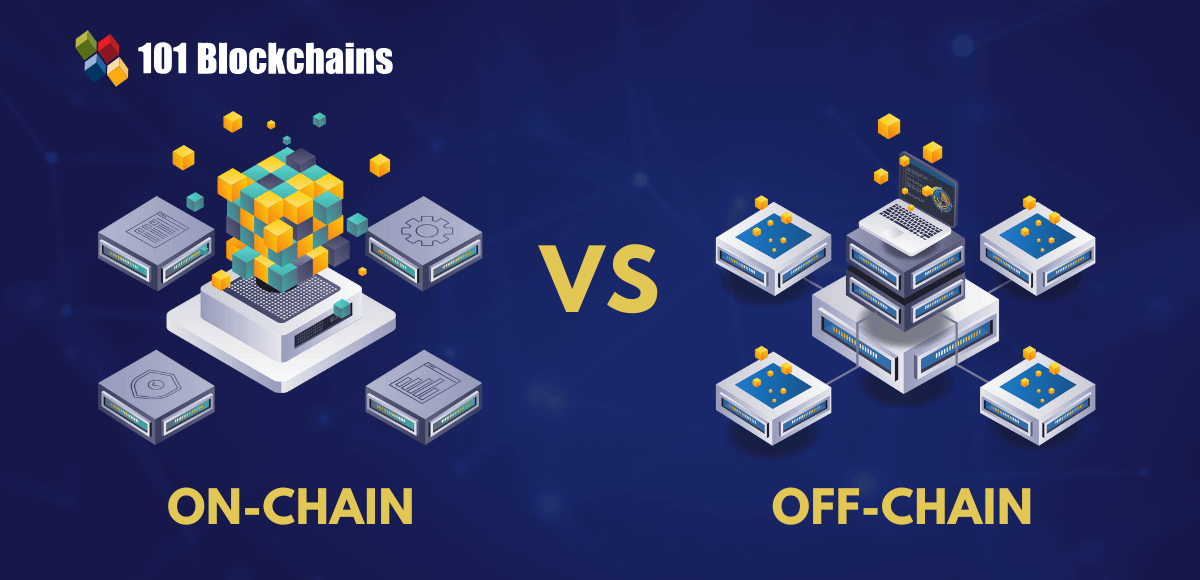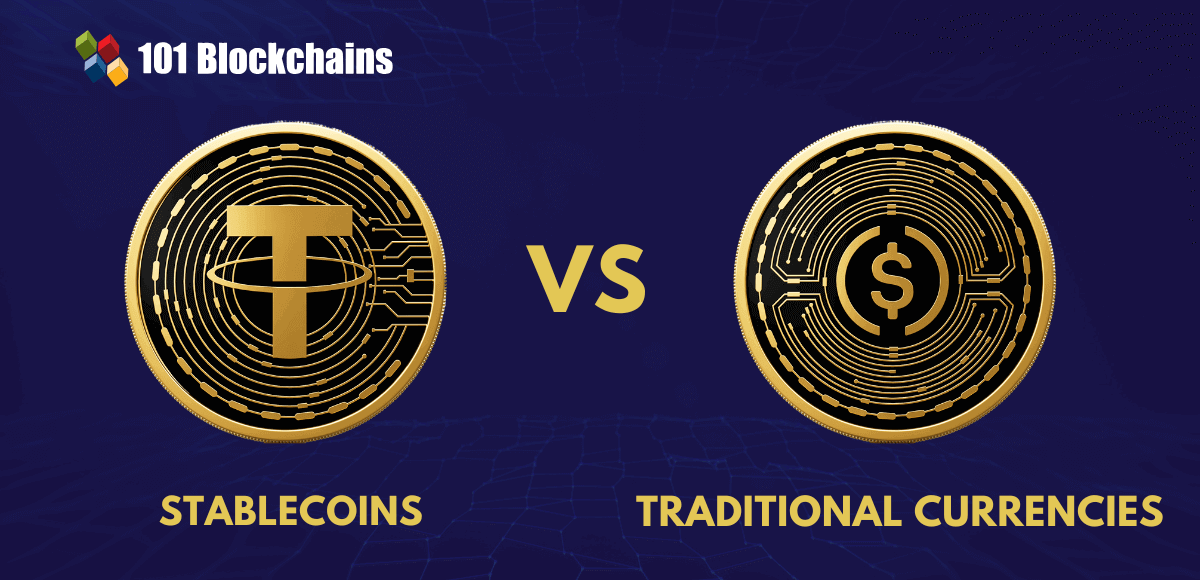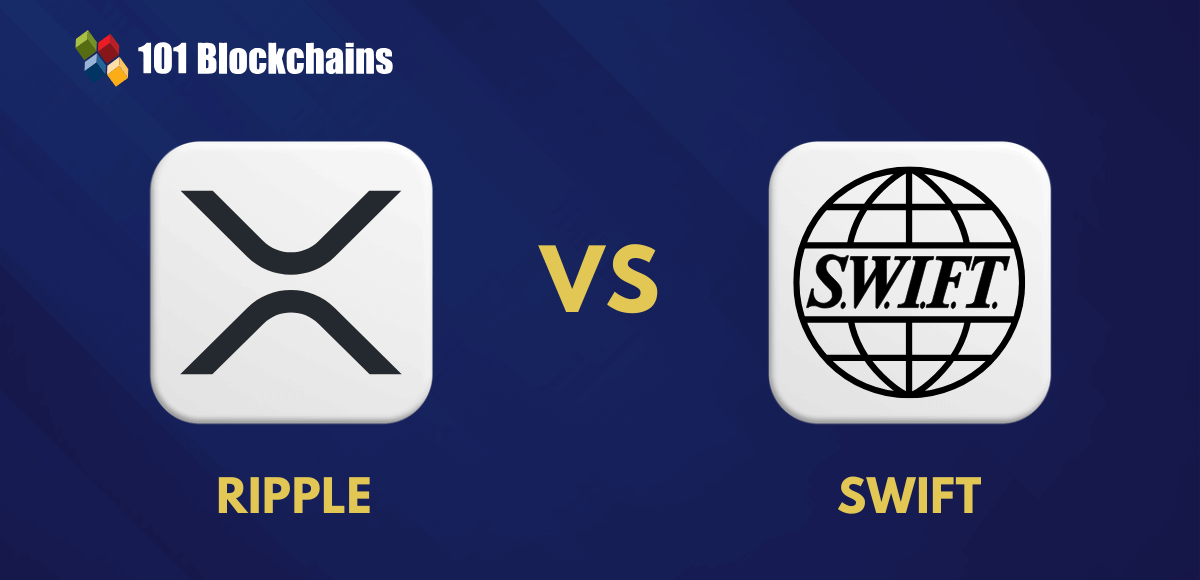Learn how blockchain truly works, master key definitions, and uncover what makes smart contracts so "smart." Dive into the fundamentals, gain valuable insights, and start your blockchain journey today!
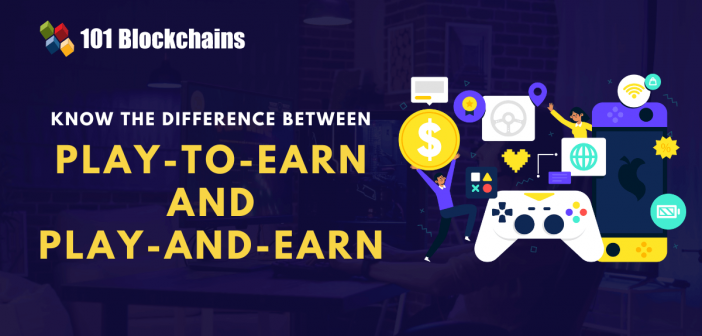
- Comparisons
James Howell
- on April 21, 2023
How Play and Earn are Better Than Play to Earn?
Gaming is one of the most popular industries in the world, with a massive base of players actively involved on different platforms. The domain has also garnered the interest of many game developers who aim to the creation of new and innovative games. Where does the play and earn vs play to earn debate come into the equation? The use of blockchain technology in gaming started off in the 2020s with new ways for monetization of games. GameFi offered the foundations for monetizing gaming experiences through the use of blockchain technology. The new concept blends smart contracts, game mechanics and NFTs into virtual environments where players could earn rewards in tokens for their participation. The play-to-earn games offered the first revolutionary model for the monetization of blockchain and metaverse-based games.
However, popular P2E games such as Axie Infinity have been losing their user engagement alongside a swift decline in the pricing of native tokens. Therefore, solutions like play and earn games are the next step forward in the GameFi revolution. It is important to learn how P2E games differ from play and earn games to determine the better alternative. Let us learn more about the differences between the play and earn and P2E games in the following post.
Definition of Play to Earn
The first thing you need to identify answers for, ‘Why play and earn is better than play-to-earn?‘ is the definition of the P2E model. It is a unique GameFi model which garnered traction during the pandemic in 2020. The name suggests everything about the play-to-earn or P2E model and how it works. Players have to finish quests, win battles or create assets and experiences in games to earn in-game tokens as rewards. Subsequently, players could exchange the native tokens of the gaming platform for fiat currency on designated marketplaces.
The thought of earning rewards that you can convert into real money while playing games is probably the dream of many people. Many of you would assume that the P2E concept in gaming is practically implausible. However, blockchain has made it possible to introduce play-to-earn crypto rewards and also facilitate significant improvements in the gaming industry. For example, players could exercise ownership over their in-game assets and experiences. Players have complete control over monetization for their in-game assets and how they are used.
The prospects of economic incentives and profits in the play-to-earn metaverse games have led to significant issues. Most of the players perceive that P2E games cannot offer gameplay that can attract existing gamers who play engaging and intricate games. The primary objective of P2E is the assurance of profits, which draws attention away from the gameplay experience. As a matter of fact, the majority of P2E games depend on the steady influx of new players willing to invest in these games. The initial investments by players are essential for facilitating profits to the players for their achievements. You can notice how the inadequacies in the game economics could prompt the easy devaluation of in-game items and rewards.
What Are the Problems of the Play to Earn Model?
The necessity of earn-and-play alternatives in GameFi spells a significant milestone in the future of gaming. Blockchain technology and the benefits of immutability, decentralization and verifiable proof of ownership have revolutionized gaming. Rather than paying to play games, blockchain enables players to earn rewards that they could redeem for real currency. Therefore, blockchain would remain the primary foundation for creating the future of video games. However, the same assumption is difficult in the case of P2E games.
Forbes has pointed out that play-to-earn games have been generating humongous revenues by leveraging NFT transactions. One of the biggest entries among P2E games is Axie Infinity, which has an impressive user base with 2.5 million daily active users on the platform. In August 2021, the platform achieved the $1 billion mark in sales. The success of Axie Infinity, particularly in the Philippines, encouraged the rise of many P2E games.
Almost every game developer wanted to capitalize on the play-to-earn crypto gold rush by creating the next Axie Infinity competitor. Where is the problem with P2E? In 2022, the hype for P2E games gained more momentum. However, the most successful games in the domain have started noticing the signs which affect their longevity in the market. The market giants in the P2E domain realized that players would soon uncover the façade running as an attractive front for P2E. Axie Infinity has announced plans for introducing modifications that would improve graphics and gameplay.
Now, you can notice the problems with the play-to-earn model in GameFi. With the primary goal focused on economic benefits, P2E games tend to compromise on substance. The games focus only on the rewards without paying attention to the basics of game design and how games drive engagement. As the GameFi landscape evolves, you cannot expect players to participate in a clipart-based game with fuzzy graphics for tokens.
Want to get an in-depth understanding of non-fungible tokens (NFTs)? Become a member and get free access to NFT Fundamentals Course.
What are Play and Earn?
The problems with play-to-earn metaverse games have resulted in stereotyping of blockchain games as boring games. As a matter of fact, some web2 gamers believe that P2E games are scams intended to exploit money for gamers in return for tokens. However, the ‘boring’ part of P2E games serves as a formidable setback for their long-term adoption. The mistakes in play-to-earn crypto reward-based games opened the roads for play-and-earn games. The new model has been tailored to shift the focus of blockchain-based gaming toward gameplay experiences.
Almost every gamer participates in a game for the sake of fun rather than with goals for financial incentives. Gamers are not always concerned about earning financial rewards and look for ways to enjoy the gameplay experience. Before the play-to-earn model, gamers used pay-to-play games and were willing to spend money on purchasing in-game items. GameFi changed the conventional norm, albeit without any thought to the gameplay experience. Why would you play a game if it is not enjoyable?
The play-and-earn or play-to-own model has emerged as a prominent alternative to the P2E model by resolving issues such as game economics and boring gameplay. In addition, play and earn also removes the barriers to entry and accessibility to gameplay without the expectation of rewards. The free-to-play option in blockchain-based games could create opportunities for faster web3 adoption. Playing and earning games could help in earning rewards for playing the game rather than devoting time to achieving goals. The play-and-earn blockchain-based games also have better prospects for sustainability. Play and earn games don’t have to depend on a set of skilled or dedicated players to drive revenue.
Get familiar with the terms related to Web 3.0 with Web 3.0 Flashcards
Difference between Play to Earn and Play and Earn Games
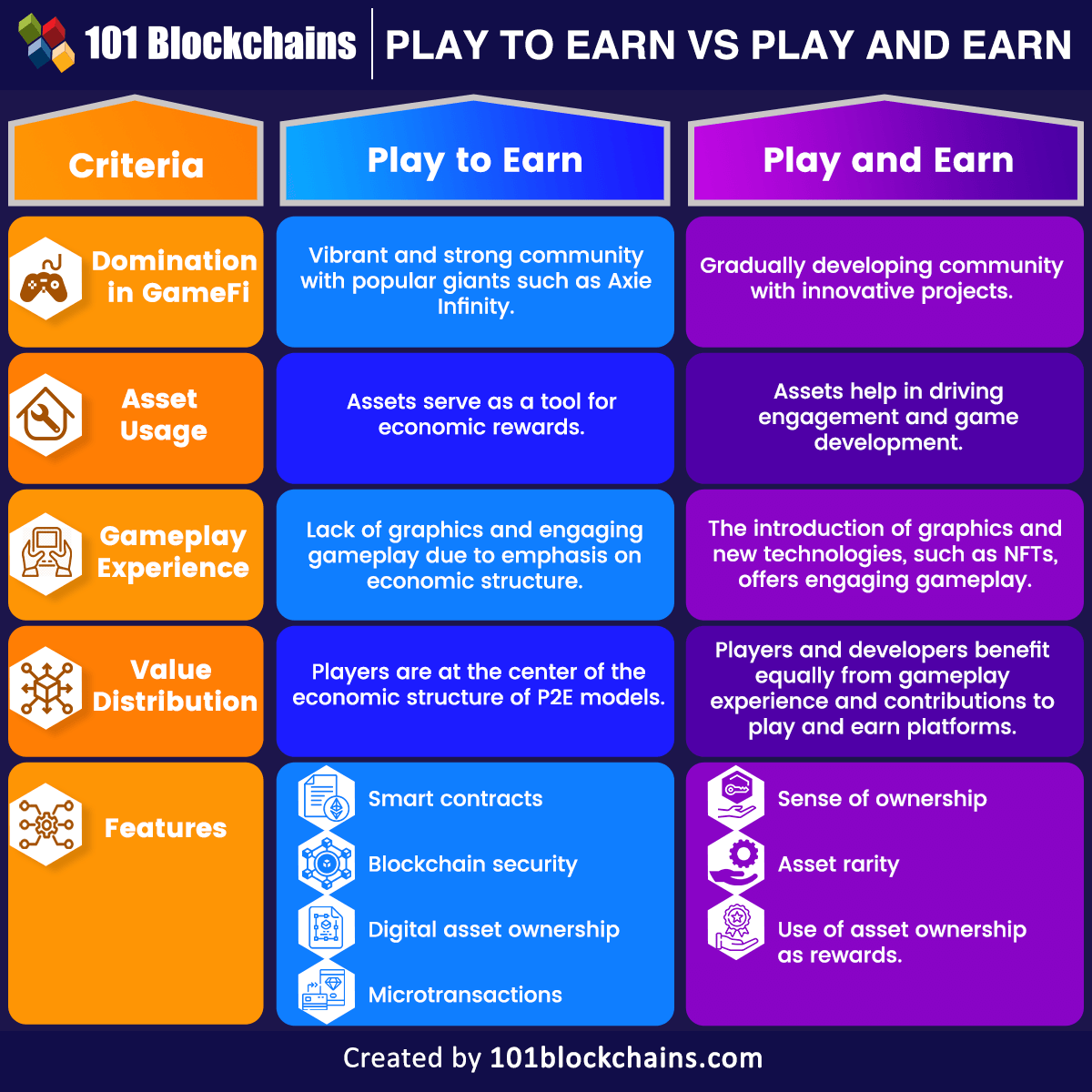
Please include attribution to 101blockchains.com with this graphic. <a href='https://101blockchains.com/blockchain-infographics/'> <img src='https://101blockchains.com/wp-content/uploads/2023/03/Play-to-Earn-Vs-Play-and-Earn.png' alt='play and earn vs play to earn='0' /> </a>
The improvements with play and earn games provide a glimpse of the balance in a play and earn vs play to earn games debate. Play and earn aims to make blockchain-based games more interesting and encourage more players to shift from web2 to web3. The difference between these two models is clearly evident in the difference between the concepts underlying each of them. You should also look up other factors that separate the two GameFi models. Here is an outline of the comparison between the play and earn and P2E games.
-
Domination over the Market
The first highlight in comparison of play-to-earn games with play-and-earn games is the domination over the market. Web2 gamers may dismiss P2E games as boring games. However, it is impossible to deny that most of the games in the GameFi landscape right now are P2E games. For example, Axie Infinity has a strong and vibrant community that keeps growing every day. The use of reward sharing through collaborations with other players in the P2E model also boosts the expansion of P2E games.
On the contrary, the play and earn or play to own concept is a recent addition to the world of GameFi. Interestingly, the play and earn games community is also increasing at a steady pace. Furthermore, innovative projects in the play and earn space, such as Project Hive, could ensure that the ‘earn and play’ model gains dominance in GameFi.
-
Asset Use
The next important aspect in defining answers to “Why play and earn is better than play-to-earn?” would point to asset utilization. Asset usage is one of the significant differentiators between play and earn and P2E games. The P2E model focuses more on the financial rewards and earning aspect, which encourages players to use their in-game assets to obtain virtual money, which they can use for real-world purchases.
On the contrary, the play and earn model focus more on earning money and using their earnings for upgrading digital assets. For example, Project Hive has introduced better graphics and gameplay alongside integrating NFTs into the game. Gamers could access all the in-game items as NFTs and use an ingenious item crafting system. Players could craft new traits and incorporate them into items to create powerful builds. The complete ownership and control of in-game assets offer flexibility for creating, upgrading and trading crafted items. Therefore, the ‘earn and play’ model also ensures that players are actively involved in the development of the game.
-
Gameplay Experience
The most common point of comparison in a play and earn vs play to earn debate is the gameplay experience. P2E games lose the battle in this case as they focus largely on earning mechanisms. As the gameplay experience in P2E games cannot garner the attention of gamers, developers rely on the economic structure as a value proposition.
On the other hand, play-and-earn games focus on offering better gameplay experiences that can engage players. The future of play-to-earn metaverse games would shift towards the play-and-earn models, which can help players enjoy the games. Play and earn games are a formidable example of pushing the envelope in the use of blockchain technology for game development. Gameplay and graphics would obviously serve as the primary highlights of play and earn games. However, play and earn games would also evolve through melding storytelling and new technologies in the gameplay experience.
-
Value Distribution between Players and Developers
Players and developers are the two integral aspects of the gaming community. How do play and earn and P2E games distribute value between players and developers? The play-to-earn crypto games focus on the financial rewards for users from their gameplay experience. The games focus only on attracting more players for expansion as new players struggle to align with their strategy. At the same time, the P2E business model creates discrepancies in value distribution with dispersed groups of players.
The answers to “Why play and earn better than play-to-earn?” would focus on how to play and earn offers advantages in value distribution. Players and developers have the opportunity to access a better deal. First of all, players could have the privileges of long-term usage and value-building activities. At the same time, players could also contribute to the development of the games, thereby enabling support to developers. The design of play-and-earn games can encourage community involvement to ensure equitable value distribution between players and developers.
-
Notable Features
The most crucial point of difference between play and earn and play to earn games would refer to their features. The notable features of a specific gaming model can attract new players. P2E games have unique features, such as smart contracts offering decentralized control over assets and game experiences. The facility of micro-transactions could offer better ease of playing P2E games. Furthermore, play-to-earn metaverse games also feature the evident benefits of security with blockchain.
The ‘earn and play’ model also offers digital assets as rewards for players in return for playing the game. Digital assets in the play-and-earn model can offer complete authority of ownership over the digital assets earned as rewards. On top of it, the rarity of assets in play and earn games add value for players.
You can find a detailed overview of the differences between the play and earn and play-to-earn games in the following table.
Bottom Line
The difference between play and earn and P2E games validates questions like “Why play and earn better than play-to-earn?” with clear reasons. Play and earn not only revolutionizes GameFi with captivating graphics and new gameplay experiences but also focuses on player engagement. The active involvement of players is an essential requirement for the long-term sustainability of blockchain-based games. Therefore, it is reasonable to assume that the ‘earn and pay’ model would be the future of blockchain games. Learn more about the world of blockchain games and their mechanics in detail now.
*Disclaimer: The article should not be taken as, and is not intended to provide any investment advice. Claims made in this article do not constitute investment advice and should not be taken as such. 101 Blockchains shall not be responsible for any loss sustained by any person who relies on this article. Do your own research!




